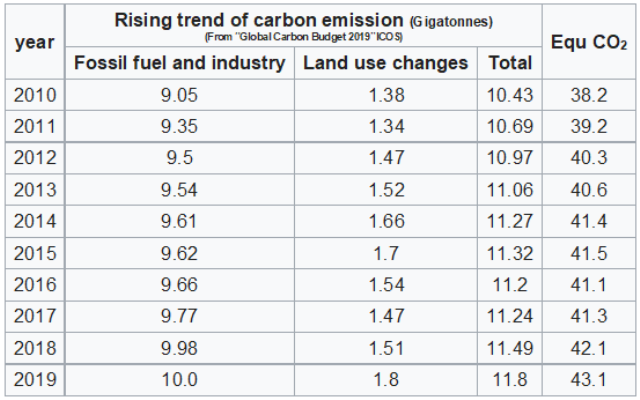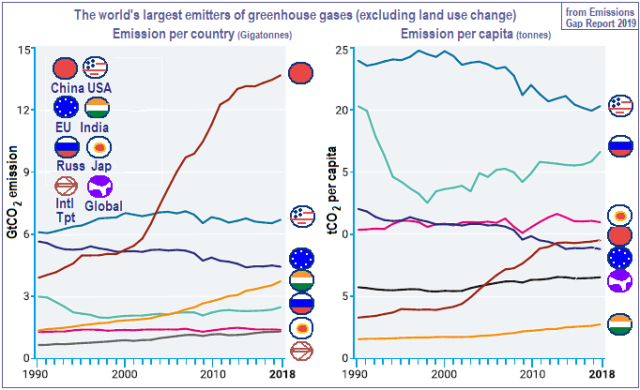A wasted decade
Should the earth slip into ruin by default?
S.Ananthanarayanan
The Paris summit of 2015 saw 192 nations of the world get together to find ways to limit global warming and stave disaster. This was to follow up the Copenhagen accord of 2009 and the Cancun meet of 2011, where 42 developed and 44 developing countries
confirmed pledges to keep warming down to 2°C, and to try for 1.5°C.
Niklas Höhne, Michel den Elzen, Joeri Rogelj, Bert Metz, Taryn Fransen, Takeshi Kuramochi, Anne Olhoff, Joseph Alcamo, Harald Winkler, Sha Fu, Michiel Schaeffer, Roberto Schaeffer, Glen P. Peters, Simon Maxwell and Navroz K. Dubash, from institutes in
Germany, the Netherlands, Denmark, UK, USA, Norway, Brazil and India, in a paper in the journal, Nature, have reviewed the progress made over the last ten years. They find that window of 30 years, which was available in 2010, has shrunk to just 10 years.
And the extent of reduction in emissions that needs to be achieved in this short period has increased. “…even if all unconditional Nationally Determined Contributions (NDCs) under the Paris Agreement are implemented, we are still on course for a 3.2°C temperature
rise,” says the 2019 review by the United Nations Environment Programme.
As late as 2015 and the Paris summit, scientists were speaking of a 2°C rise in global temperature being acceptable. But we now know that 2°C would be too high and we need to achieve the target of 1.5°C. During the last 10 years, since we committed to
the 2°C limit, however, the world did not work towards the target, it moved away and increased the task at hand.
The task, of course, is to rein in the levels of CO2 in the atmosphere, which became alarming when it rose beyond 400 parts per million – corresponding to 3,132 Giga-tonnes (billion tonnes) of CO2. The level has been rising and was reported to be at 415
parts per million, or 3,250 Giga-tonnes in 2019. It is estimated that since 1959, some 350 Gt of CO2 have been emitted, of which some 55% has been absorbed by the processes on land and the sea. Once in the atmosphere, however, CO2 stays put, till it is absorbed
or fixed as carbohydrates by vegetation and sunlight. While the capacity of these CO2 sinks stays nearly unchanged, the emission has been rising, and studies have shown that business as usual would take CO2 levels and the rise in temperature so high that human
life as we know it may be impossible by the end of the century.
Hence the series of international conclaves, to create the awareness and impose on States the obligation to find ways, mainly of reducing the use of fossil fuels and the pressure of land, to retard, and then reverse, the rising load of CO2 in the atmosphere.
What the world thought in 2010, the paper in Nature says, was that we had till 2040 to reduce to half the level of emissions. But we now need to do it by 2030, and there is more to do in the shorter time we have.
“Had serious climate action begun in 2010, the cuts required to meet the emissions levels for 2 °C would have been around 2% per year, on average, up to 2030,” the paper says. But in place of reduction, the levels of emission have steadily risen (see table
). Against even the annual 43.1 Gt CO2 equivalent estimated for 2019, the paper cites the UN report that says emissions are at 55.3 Gt a year in 2018. The current estimate is that if we plan to limit temperature within the window available, the “emission cuts
required cuts from 2020 are more than 7% per year on average for 1.5 °C (close to 3% for 2 °C),” the paper says.

The study in Nature is an analysis of the data that the United Nations has been collecting every year, since 2010. This data, the Emissions Gap Report, is the comparison, by UN Environment Programme, of the action that the nations of the world have taken,
individually, against what they should have, collectively, and the excess of emissions that we need to eliminate to avoid the worst impacts of climate change.
From the UNEP report
“If we rely only on the current climate commitments of the Paris agreement, temperatures can be expected to rise by 3.2°C this century. Temperatures have already increased by 1.1°C, leaving families, homes and communities devastated.”
“We need to close the ‘commitment gap’, between what we say and what we need to do, to prevent dangerous levels of climate change. Governments cannot afford to wait. People and families cannot afford to wait. Economies must shift to a decarbonisation pathway
now.”
“We have to learn from our procrastination. Any further delay brings the need for larger, more expensive and unlikely cuts. We need quick wins, or the 1.5°C goal of the Paris Agreement will slip out of reach”
-Inger Andersen, Executive Director, UNEP
The annual review, over the last decade, has clearly not served its purpose as a means of monitoring progress. The review, and the idea of the ‘gap’, however, the paper says, has helped keep UN summits adequately informed. But “the past decade of political
failure has cost us all dear,” the paper says in its opening sentence. And its synthesis of the ten annual reports since 2010, in preparation for the review to take place in Glasgow later this year, hopes to get nations to overhaul their promises. And then,
crucially, to keep them — “if the yawning gap between ‘talk and walk’ is going to close by 2030.”

To build on earlier accords and mark out the course for their implementation was also what the summit of 2015 had intended. If the meet in Glasgow is to have any meaning, it is essential that more forces come into play than just the UN resolve to get
governments together. The world cannot afford to let politicians fiddle while the earth, quite literally, gets ready to burn. This country has seen the courts of law being moved to enforce several provisions that are of public interest. Could there be a more
human rights issue than the need to control global warming? Could mass awareness force the hands of governments, so that the voices of Greta Thunberg and Licypriya Kangujam do not go unheard?
[the writer can be contacted at response@simplescience.in]